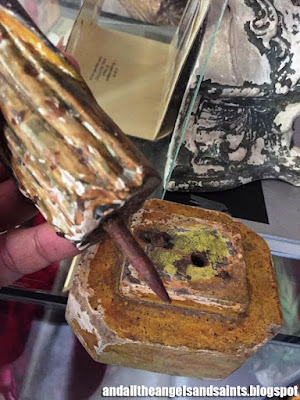This small, but incredible piece of religious folk art, came
by way of an antique dealer from Bulacan, who kept popping in at odd days
in my Makati office, bearing all kinds of “antique finds”.
 |
| Simple carving characterized this Cristo |
 |
| Silver potencias shaped like sun's rays |
So the next time he called to say that he had an antique to
show again, I told him to quit it! But he kept on waxing praises about how rare
it was—Scourging at the Pillar carving—with silver tapiz and potencias incised with ysot design,
human hair wig, folksy carving that fits my taste—--which began to intrigued
me. This time, I asked him to meet me at my Makati place, where our wheeling
and dealing would be more discreet.
 |
| The figure is painted in ashen white |
 |
| This Cristo has an expressionless gaze |
The face of Christ itself bore no trace of agony nor tension, what with his big, downcast but staring eyes and expressionless lips. He actually has carved short hair, but was meant to wear a human hair wig over it. He has large protuding ears, carved without much details.
 |
| Note the child-like fingers |
In contrast to the plain-ness of the carving which is
characterized by it folk art quality, its silver metal accessories are
outstanding. The 3 potencias mimic the rays of the sun, very similar to the
sun’s rays on the Philippine flag. They are decorated in ysot (etched) style.
 |
| Trefoil foliage on the pukpok tapiz |
Imagine, I had meant to dismiss this dealer because of his obstructive ways, and if I had done that today, I would have missed this fabulous piece of ancient Philippine sacred art. Smitten with this rare find, I lost no time in haggling with the dealer about its price, and we arrive successfully and painlessly with the final price tag.
Since then, I have been offered much more by other antique
dealers who recognize the quality of this Cristo at the pillar. I have no plans
of letting it go. The only time this Cristo gets out of my sight is when he is borrowed for a
traditional Lenten Exhibit of the Carmelite brothers every March. At least, he
gets to be seen and enjoyed by santo aficionados who truly appreciate the
antiquity and naïve beauty of ancient Philippine santo art.
**********




























